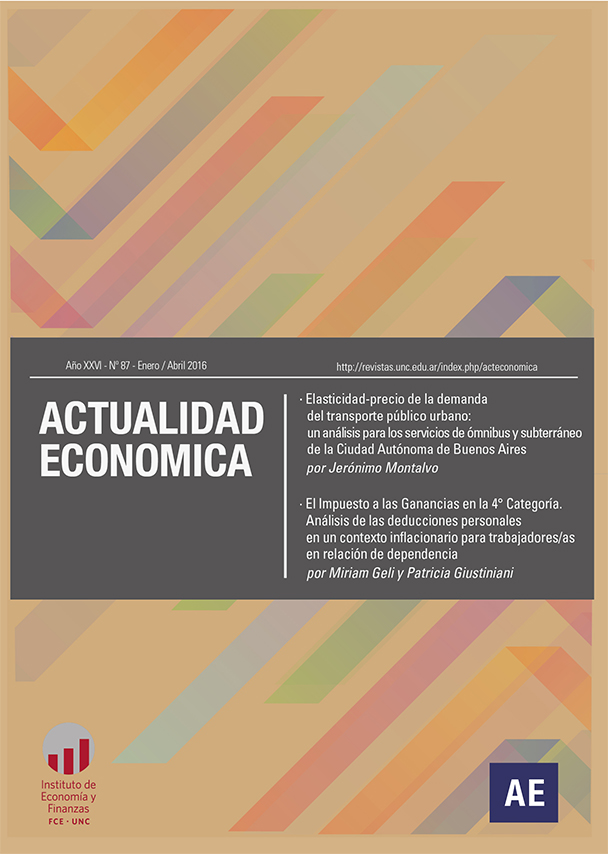Income tax in the 4th category. Analysis on the personal deductions in an inflationary context for employees
Keywords:
Income tax, Inflation, deductions, working as employees.Abstract
The current inflationary context affects Income Tax setting as applied to employees in Argentina. The lack of a regular updating of its components distorts the tax burden and generates the payment of a tax on income which is part of “subsistence” expenses. We analyze whether the application of current legislation complies with the principles of tax-paying capacity, equity and progressivity. In order to find a high-income parameter, we draw an analogy with the concept of poverty using the total basket of goods and services as unit of measurement for the cases proposed. We conclude that a modification in the scale for lower income segments, in non-taxable minimums and in personal deductions would avoid the burden of distributive policies falling on middle-income taxpayers’ wages.
Downloads
References
Allan, C.M. (1971). La teoría de la tributación; primera edición; Alianza Editorial; Madrid.
Bevacqua, G. (2015). “Estimaciones de la Canasta Básica Alimentaria y Básica Total”; En Infobae. Disponible en: http://www.infobae.com/2015/04/08/1720992-ex-directora-precios-del-indec-estimo-9822-el-umbral-pobreza-la-ciudad
Basualdo, E. (2014). “Impuesto a las Ganancias cuarta categoría. Cifra Informes de Coyuntura. Disponible en: http://www.centrocifra.org.ar/docs/IC%20Nro%2016%20(segundo%20adelanto).pdf
Costa, D. (2015). “Canasta Familiar a Marzo de 2015”; Disponible en: http://adusl.unsl.edu.ar/canastamarzo2015.pdf
Due, J F. (1984). Análisis económico de los impuestos; Ed. El Ateneo; Buenos Aires
García Vizcaíno, C. (1999). Derecho Tributario: consideraciones económicas y jurídicas; Ed. Depalma, Buenos Aires.
Garriga, M. y Rosales W. (2013). “Finanzas Públicas en la práctica. Selección de casos y aplicaciones”. Facultad de Ciencias Económicas. Universidad Nacional de La Plata.
Geli M., Giustiniani P., Goytía M. (2014). “Distorsiones que produce la inflación en el Impuesto a las Ganancias de la 4º Categoría. Un análisis a partir de casos de la realidad argentina”. 47 Jornadas Internacionales de Finanzas Públicas.
Argañaraz, N; Mir, A; 2015; “El impuesto a las Ganancias de Trabajadores en Relación de Dependencia. Una Comparación Regional”; IARAF- Informe Económico Nº 305.
Argañaraz, N; Mir, A. (2014). “Ganancias y Bienes Personales para todos. ¿Habrá cambios este año?”; IARAF-Informe Económico 263.
Instituto Nacional de Estadísticas y Censos de la República Argentina-INDEC (2014). Distribución del Ingreso. Tercer trimestre 2014.
Iturrioz, E. (1981). Curso de Finanzas Públicas; Ed. Ediciones Macchi, Buenos Aires.
Musgrave, R. A.; Musgrave, P. B. (1991). Hacienda Pública Teórica y Aplicada. Ed. Mc Graw-Hill, Buenos Aires.
Piketty, T. (2014). El capital en el siglo XXI, Editorial Fondo de cultura económica; Primera Edición; Ed. Fondo de Cultura Económica; Buenos Aires.
Rebak, .Roque Juez Federal - Provincia de Córdoba- Argentina. Aceptación de Recurso de Amparo
Resolución General Nº 3770 AFIP.
Runciman, W.G. (1966). Relative deprivation and social justice, London: Routledge Kegan Pau; International Journal of Comparative Sociology.
Sabaini J.C., Santieri J.J., Rossignolo D.A.;(2002). “La equidad distributiva y el sistema tributario: un análisis para el caso argentino”. Disponible en: http://www.cefid-ar.org.ar/documentos/DT40.pdf
Sen, A. (1985). Commodities and Capabilities.: Ed. North-Holland; Amsterdam
Spicker, P; Leguizamon, S. A.; Gordon, D. (2009). Pobreza: Un glosario internacional. Buenos Aires; Consejo Latinoamericano de Ciencias Sociales. Disponible en: http://biblioteca.clacso.edu.ar/
Downloads
Published
Issue
Section
License
Those authors who have published with this journal, accept the following terms:
Authors will conserve their copyright and guarantee the magazine the right of first publication of their work, which will be simultaneously subject to the Creative Commons Attribution-NonCommercial-NoDerivative 4.0 International License that allows third parties to share the work as long as the author and first publication of this magazine are indicated.
Authors may adopt other non-exclusive license agreements to distribute the published version of the work (e.g., deposit it in an institutional telematic archive or publish it in a monographic volume) provided that the initial publication in this journal is indicated.
Authors are allowed and encouraged to disseminate their work through the Internet (e.g., in institutional telematic archives or on their website) before and during the submission process, which may lead to interesting exchanges and increase citations of the published work. (See The effect of open access)









